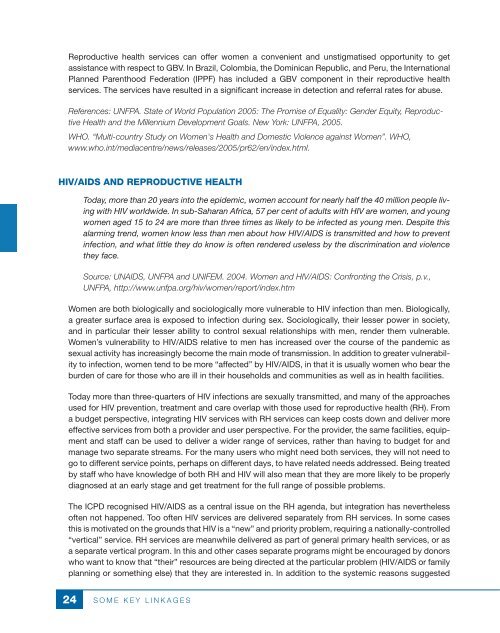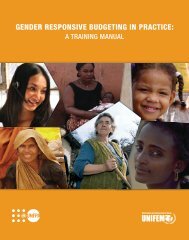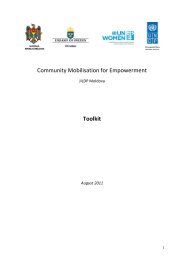Gender Responsive Budgeting and Women's Reproductive Rights ...
Gender Responsive Budgeting and Women's Reproductive Rights ...
Gender Responsive Budgeting and Women's Reproductive Rights ...
Create successful ePaper yourself
Turn your PDF publications into a flip-book with our unique Google optimized e-Paper software.
<strong>Reproductive</strong> health services can offer women a convenient <strong>and</strong> unstigmatised opportunity to getassistance with respect to GBV. In Brazil, Colombia, the Dominican Republic, <strong>and</strong> Peru, the InternationalPlanned Parenthood Federation (IPPF) has included a GBV component in their reproductive healthservices. The services have resulted in a significant increase in detection <strong>and</strong> referral rates for abuse.References: UNFPA. State of World Population 2005: The Promise of Equality: <strong>Gender</strong> Equity, <strong>Reproductive</strong>Health <strong>and</strong> the Millennium Development Goals. New York: UNFPA, 2005.WHO. “Multi-country Study on <strong>Women's</strong> Health <strong>and</strong> Domestic Violence against Women”. WHO,www.who.int/mediacentre/news/releases/2005/pr62/en/index.html.HIV/AIDS <strong>and</strong> reproductive healthToday, more than 20 years into the epidemic, women account for nearly half the 40 million people livingwith HIV worldwide. In sub-Saharan Africa, 57 per cent of adults with HIV are women, <strong>and</strong> youngwomen aged 15 to 24 are more than three times as likely to be infected as young men. Despite thisalarming trend, women know less than men about how HIV/AIDS is transmitted <strong>and</strong> how to preventinfection, <strong>and</strong> what little they do know is often rendered useless by the discrimination <strong>and</strong> violencethey face.Source: UNAIDS, UNFPA <strong>and</strong> UNIFEM. 2004. Women <strong>and</strong> HIV/AIDS: Confronting the Crisis, p.v.,UNFPA, http://www.unfpa.org/hiv/women/report/index.htmWomen are both biologically <strong>and</strong> sociologically more vulnerable to HIV infection than men. Biologically,a greater surface area is exposed to infection during sex. Sociologically, their lesser power in society,<strong>and</strong> in particular their lesser ability to control sexual relationships with men, render them vulnerable.Women’s vulnerability to HIV/AIDS relative to men has increased over the course of the p<strong>and</strong>emic assexual activity has increasingly become the main mode of transmission. In addition to greater vulnerabilityto infection, women tend to be more “affected” by HIV/AIDS, in that it is usually women who bear theburden of care for those who are ill in their households <strong>and</strong> communities as well as in health facilities.Today more than three-quarters of HIV infections are sexually transmitted, <strong>and</strong> many of the approachesused for HIV prevention, treatment <strong>and</strong> care overlap with those used for reproductive health (RH). Froma budget perspective, integrating HIV services with RH services can keep costs down <strong>and</strong> deliver moreeffective services from both a provider <strong>and</strong> user perspective. For the provider, the same facilities, equipment<strong>and</strong> staff can be used to deliver a wider range of services, rather than having to budget for <strong>and</strong>manage two separate streams. For the many users who might need both services, they will not need togo to different service points, perhaps on different days, to have related needs addressed. Being treatedby staff who have knowledge of both RH <strong>and</strong> HIV will also mean that they are more likely to be properlydiagnosed at an early stage <strong>and</strong> get treatment for the full range of possible problems.The ICPD recognised HIV/AIDS as a central issue on the RH agenda, but integration has neverthelessoften not happened. Too often HIV services are delivered separately from RH services. In some casesthis is motivated on the grounds that HIV is a “new” <strong>and</strong> priority problem, requiring a nationally-controlled“vertical” service. RH services are meanwhile delivered as part of general primary health services, or asa separate vertical program. In this <strong>and</strong> other cases separate programs might be encouraged by donorswho want to know that “their” resources are being directed at the particular problem (HIV/AIDS or familyplanning or something else) that they are interested in. In addition to the systemic reasons suggested24S O M E K E Y L I N K A G E S





